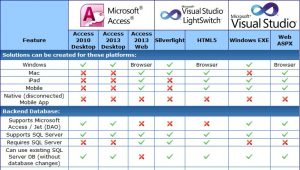Last month I spoke at the Portland Access Users Group Conference at Silver Falls State Park. I gave a presentation introducing Visual Studio LightSwitch and how it could be used for SQL Server applications deployed on a variety of platforms. As a follow-up, I’ve created a summary matrix and discussion that highlights the features and limitations of the variety of platforms from Microsoft Access, Visual Studio LightSwitch, and Visual Studio.
Microsoft Access started at the beginning of the Windows revolution 20+ years ago and became the most popular database of all time. More recently, additional technologies have become significant, so it behooves the Microsoft Access community to be aware of the trends and options.
Ultimately, it’s about being able to create solutions that help you and/or your users accomplish their mission. Sometimes the user’s platform is critical, sometimes, it’s the data source, and other times it’s the permissions you have to deploy a solution. A variety of platforms and options are available with benefits and limitations with each. Meanwhile, Microsoft Access is also evolving with their latest Access 2013 version offering new web based solutions.
We’ve written a new paper, Comparison of Microsoft Access, LightSwitch and Visual Studio Platforms for Database Developers that summarizes what we’re seeing and experiencing.







